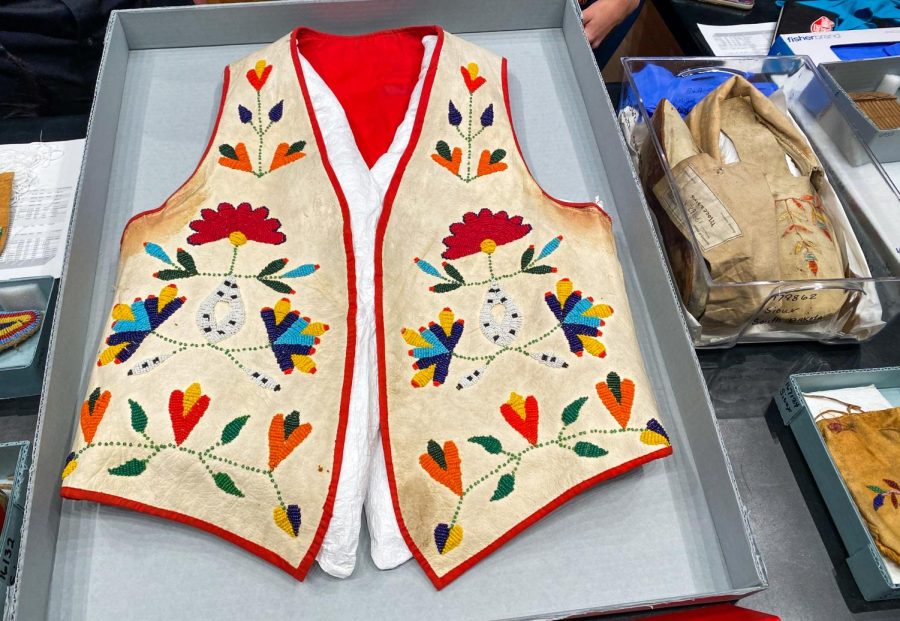Field Museum celebrates Native American Heritage Month with beadwork presentation
Iris Swarthout/The Daily Northwestern
Beaded Dakota vest. It showcases a combination of the woodlands and prairie indigenous beading techniques.
November 8, 2021
The Field Museum kicked off National Native American Heritage Month with a Friday demonstration of traditional beadwork technique.
The showcase is the first in a series of Native American heritage events throughout the month of November. Michelle Brownlee, a member of the Ojibwe Tribe, and J. Kae Good Bear, a member of the Navajo Nation, Mandan and Hidatsa tribes, teamed up to bring indigenous beadwork artifacts to the public eye, according to the museum’s public relations director, Bridgette Russell.
“It’s really important for folks to know that we’re celebrating the whole month,” Russell said. “We are so excited that J. Kae and Michelle are here to share their expertise about Indigenous culture.”
Friday’s demonstration was part of the museum’s weekly “Meet a Scientist” presentation series. Brownlee, who is the Field Museum’s collections assistant, said the presentation was an attempt to make existing programming fit Native American Heritage Month’s theme.
While there are about 770,000 items in the Field Museum’s Native American collection, she said less than 1% of them are displayed.
“Being able to provide access for folks who normally do not have access to these items is really important,” Brownlee said. “I’m thankful that I have a department that’s supportive of that.”
Although Indigenous artifact collections and presentations get better every year, Brownlee said the process of conservation takes time and energy. However, the deep cultural representation of Native heritage makes it all worth it.
Good Bear, the Field Museum’s conservation technician, said traditional Native American beadwork styles and designs differ between tribes. She added that half the items at the presentation table corresponded to plains-style beadwork and the other to woodland-style.
“(Woodland-style beadwork) can see more organic shapes … and things with leaves because you live in the woods … and that’s what you saw around you,” Good Bear said. “Versus the plains, where you don’t have the tree coverage, is where you can see more of a geometric pattern.”
While many of the artifacts presented were small fabric samples and moccasins, a large vest in the middle of the two sections represented a combination of the plains and woodland beadwork styles, Good Bear said.
She said the vest is traced to the Dakota Tribe. Brownlee added that while her tribe is located deeper within the woodlands of northern Minnesota, the Dakota tribe is closer to the plains, leaving room for cross-tribal influence.
“We are trying to also emphasize that Native American tribes are not isolated and they’re not stagnant,” Brownlee said. “This intermingling and cross cultural exchange has been going on for millennia.”
The distinctions between different tribal beadwork styles is also revealed through stitching patterns, according to Good Bear. She said woodland floral stitches are more flowy and closer to embroidery, while plains designs are more parametric in shape.
Good Bear, who is multitribal in descent, said her connection to the artifacts at the Field Museum represents an unbroken lineage to her ancestors.
“I know the significance of … every little bit of fabrication,” Good Bear said. “These are some of my favorite items because it’s just kind of a touchstone that reminds me of that connection.”
Brownlee said the museum has made Indigneous representation as accurate as possible by naming displayed items in Ojibwe, Navajo and Cherokee syllabary.
Accessibility is at the forefront of the Field Museum’s events, Brownlee said, and the Indigenous beads exhibit caters to museum visitors of all ages.
“Most of the time it’s just folks walking by and wandering,” Brownlee said. “It’s just a cool sort of artistic medium that anybody could be interested in.”
Email: irisswarthout2023@u.northwestern.edu
Twitter: @swarthout_iris
Related Stories:
— NU, Field Museum and Newberry Library co-host symposium exploring “Indigenous Interventions” in museums and archives
— Field Museum showcases work by its first African American taxidermist



